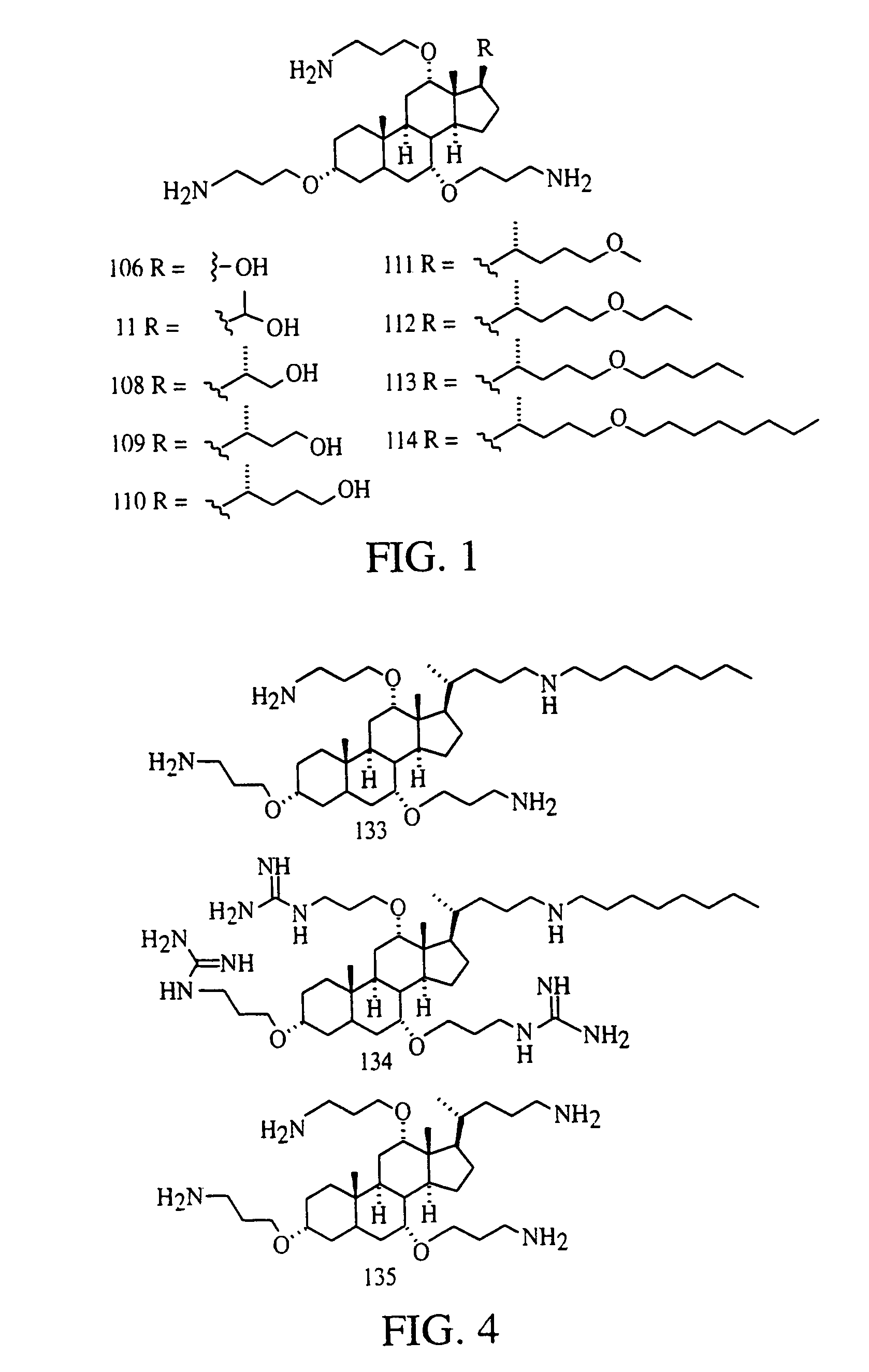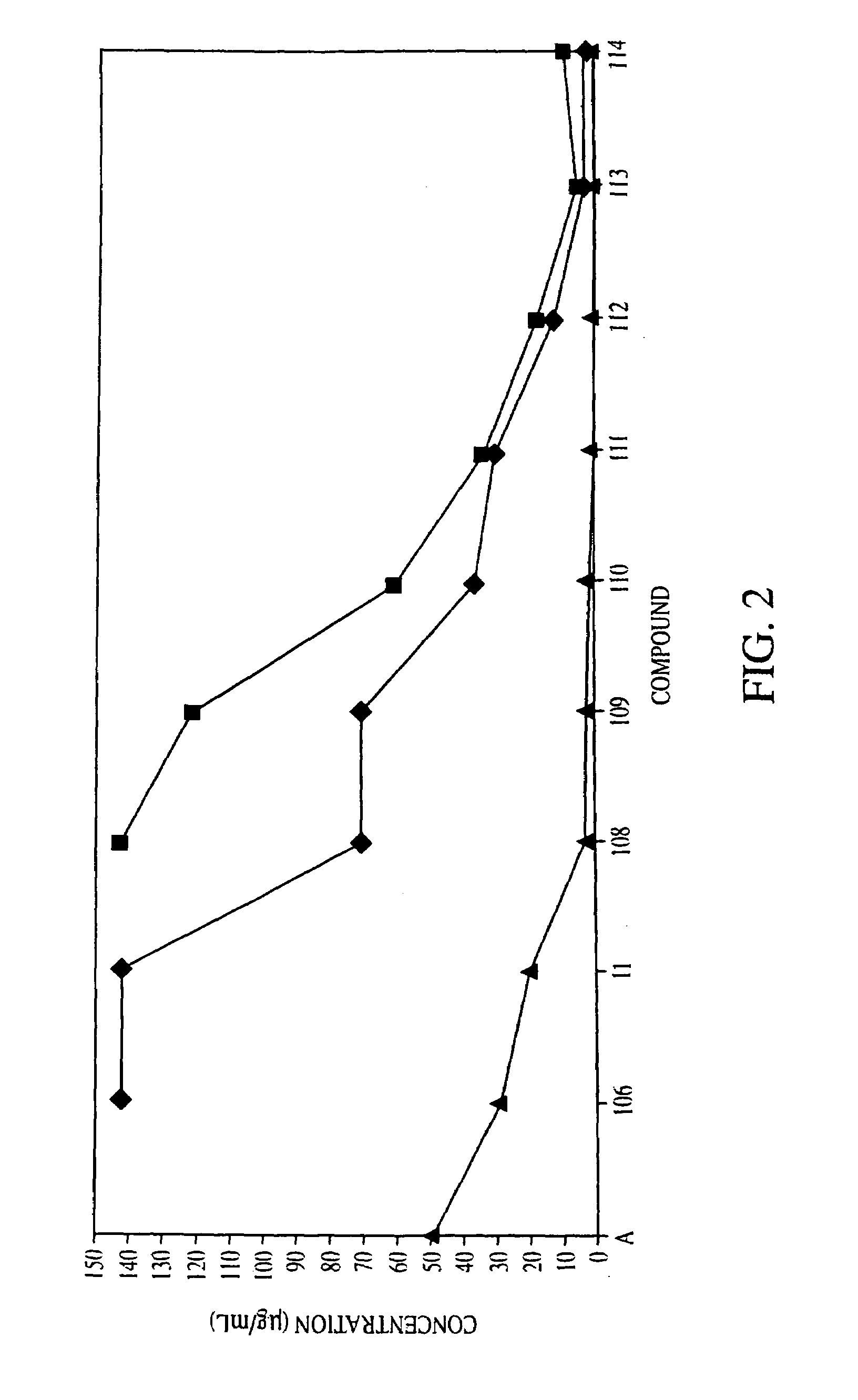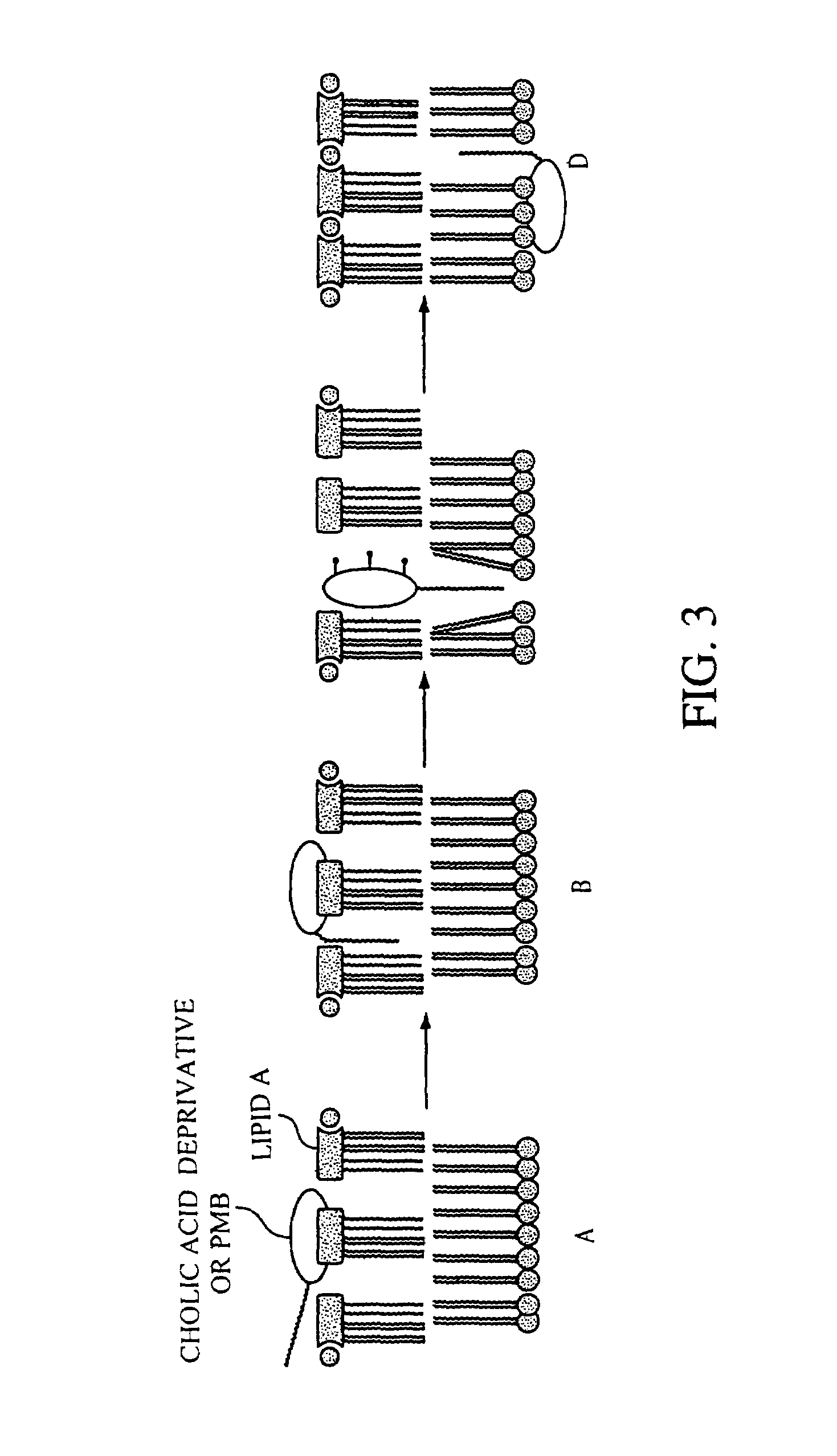Steroid derived antibiotics
a technology of antibiotics and steroids, applied in the field of steroid derivatives, can solve the problems of increasing permeability and disrupting the outer membran
- Summary
- Abstract
- Description
- Claims
- Application Information
AI Technical Summary
Benefits of technology
Problems solved by technology
Method used
Image
Examples
example 1
Syntheses of Compounds 1, 2, 4, 5, 13-20 and 22-27
[0129]Compound 13: To a 1 L round-bottom flask were added methyl cholate (30.67 g, 72.7 mmol) in dry THF (600 mL) and LiAlH4 (4.13 g, 109 mmol). After reflux for 48 hours, saturated aqueous Na2SO4 (100 mL) was introduced slowly, and the resulted precipitate was filtered out and washed with hot THF and MeOH. Recrystallization from MeOH gave colorless crystals of 13 (28.0 g, 98% yield). m.p. 236.5-238° C.; IR (KBr) 3375, 2934, 1373, 1081 cm−1; 1H NMR (CDCl3 / MeOH-d4, 200 MHz) δ 3.98 (bs, 1H), 3.83 (bs, 1H), 3.60-3.46 (m, 2H), 3.38 (bs, 5H), 2.30-2.10 (m, 2H), 2.05-1.05 (series of multiplets, 22H), 1.03 (bs, 3H), 0.92 (s, 3H), 0.71 (s, 3H); 13C NMR (CDCl3 / MeOH-d4, 50 MHz) δ 73.89, 72.44, 68.99, 63.51, 48.05, 47.12, 42.49, 40.37, 39.99, 36.62, 36.12, 35.58, 35.40, 32.77, 30.69, 30.04, 29.02, 28.43, 27.27, 23.96, 23.08, 18.00, 13.02; HRFAB-MS (thioglycerol+Na+ matrix) m / e: ([M+Na]+) 417.2992 (55.3%); calcd. 417.2981.
[0130]Compound 14: To a...
example 2
Syntheses of Compounds 3, 28 and 29
[0151]Compound 28: A suspension of 19 (0.641 g, 0.614 mmol) and KCN (0.40 g, 6.14 mmol) in anhydrous DMSO (5 mL) was stirred under N2 at 80° C. overnight followed by the addition of H2O (50 mL). The aqueous mixture was extracted with EtOAc (4×20 mL). The combined extracts were washed with brine once, dried over anhydrous Na2SO4 and concentrated in vacuo. The residue was dissolved in CH2Cl2 (3 mL) and MeOH (3 mL) and catalytic amount of p-toluenesulfonic acid (5.84 mg, 0.03 mmol) was added. The solution was stirred at room temperature for 3 hours before the introduction of saturated NaHCO3 solution (10 mL). After the addition of brine (60 mL), the mixture was extracted with EtOAc (4×30 mL). The combined extracts were washed with brine once and dried over anhydrous Na2SO4 and concentrated. The residue afforded the desired product (0.342 g, 92% yield) as pale yellowish oil after column chromatography (silica gel, EtOAc / hexanes 2:1). IR (neat) 3479, 29...
example 3
Syntheses of Compounds 6, 7, and 30-33
[0154]Compound 30: Cholic acid (3.0 g, 7.3 mmol) was dissolved in CH2Cl2 (50 mL) and methanol (5 mL). Dicyclohexylcarbodiimide (DCC) (1.8 g, 8.8 mmol) was added followed by N-hydroxysuccinimide (˜100 mg) and benzylmethylamine (1.1 g, 8.8 mmol). The mixture was stirred for 2 hours, then filtered. The filtrate was concentrated and chromatographed (SiO2, 3% MeOH in CH2Cl2) to give 3.0 g of a white solid (81% yield). m.p. 184-186° C.; IR (neat) 3325, 2984, 1678 cm−1; 1H NMR (CDCl3, 200 MHz) δ 7.21 (m, 5H), 4.51 (m, 2H), 3.87 (m, 1H), 3.74 (m, 2H), 3.36 (m, 2H), 2.84 (s, 3H), 2.48-0.92 (series of multiplets, 28H), 0.80 (s, 3H), 0.58 (d, J=6.5 Hz, 3H); 13C NMR (CDCl3, 50 MHz) δ 174.30, 173.94, 137.36, 136.63, 128.81, 128.46, 127.85, 127.50, 127.18, 126.28, 72.96, 71.76; 68.35, 53.39, 50.65, 48.77, 46.91, 46.33, 41.44, 39.36, 39.18, 35.76, 35.27, 34.76, 33.87, 31.54, 34.19, 31.07, 30.45, 28.11, 27.63, 26.14, 25.59, 24.92, 23.26, 17.51, 12.41; FAB-MS (t...
PUM
| Property | Measurement | Unit |
|---|---|---|
| concentrations | aaaaa | aaaaa |
| particle size | aaaaa | aaaaa |
| temperature | aaaaa | aaaaa |
Abstract
Description
Claims
Application Information
 Login to View More
Login to View More - R&D
- Intellectual Property
- Life Sciences
- Materials
- Tech Scout
- Unparalleled Data Quality
- Higher Quality Content
- 60% Fewer Hallucinations
Browse by: Latest US Patents, China's latest patents, Technical Efficacy Thesaurus, Application Domain, Technology Topic, Popular Technical Reports.
© 2025 PatSnap. All rights reserved.Legal|Privacy policy|Modern Slavery Act Transparency Statement|Sitemap|About US| Contact US: help@patsnap.com



